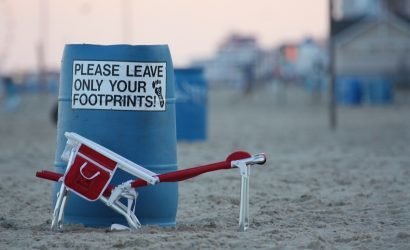On Friday morning Ocean City officials were calling hurricane Irene “Gloria on Steroids.” For anyone who doesn’t recall, Gloria was the 1985 storm that destroyed large portions of the boardwalk-the worst since the 1962 storm that caused substantial damage to the boardwalk, homes, and businesses—precipitated in damage by the storm in 1933 that cut the inlet. Every large storm in recent history—has left an indelible mark on Ocean City. Officials and residents had a valid reason to worry. By Sunday morning, the quote was, “we dodged a bullet.”
Irene was the storm to worry about—veteran locals were leaving their homes–and not just those who resided in the actual town of Ocean City. For those residents who lived further out, the worry was not the storm surge, but downed trees and projectiles coming through windows or down upon roofs. As the storm approached, town officials prepared, and the worry intensified.
It’s not often Ocean City residents are ordered out—evacuation is seldom necessary, the last time was hurricane Gloria—26 years ago. But this hurricane was different. Irene was huge, and with a low-pressure system indicative of hurricanes at a much higher level, the question initially was whether or not she would increase to a level 4. And would she then hit Ocean City as a downgraded level 2 or 3, as she progressed very slowly up the coast?
The unpredictability of Irene, as with most hurricanes, is what promoted Ocean City officials to enact Phase 1 of the evacuation plan early Thursday morning, and end with a mandatory evacuation of everyone, including residents by Friday at 5pm. That evening Ocean City was a ghost town, with just 300 residents–who were required to leave notice with police of a next of kin–deciding to ride out the storm. Also evacuated Friday were low-lying areas in West Ocean City (where many Ocean City residents had taken refuge), and homes on Route 611 and South Point across the bay from Assateague Island.
For those who evacuated—by choice or by mandate—the time spent on the roads to presumed safety was grueling. In addition to the locals exiting, were approximately 200,000 tourists on summer vacation, who had to make the trek home early. With only two ways off the Delmarva Peninsula—west and north—exiting was sometimes akin to crawling out. Trips to Philadelphia and points north were reported at eight hours–Baltimore and points west at six. For those who stayed, the question was—did we do the right thing? But there comes a certain point where it’s no longer a decision to be had—there’s a small window with these kinds of things—get out by a certain time, or risk being stuck on the roads in traffic when the storm hits, or when the bridges shut down. It’s not an easy decision to make.
Locals here are situated between immense bodies of water—the Atlantic Ocean to the east, the bays of Delaware to the north, the Sinepuxent and Assawoman bays west of Ocean City, the hundreds of rivers and tributaries, and the massive Chesapeake Bay to the west. A majority of the time, this close proximity to water indicates an envied life of boating, sunning and surfing…but for a few months out of the year, it can be cause for concern.
Irene was at one point, projected to be nearly a direct hit, as a category 2 hurricane. This fact, when accompanied by a new moon and the possibility of hitting the area at high tide, would have been a recipe for disaster. Instead, everything positive seemed to align and the only visible damage to Ocean City was to a few signs, roofs, the pier, and the jetty at the inlet—thankfully leaving Ocean City and her surrounding areas largely unscathed.
Undoubtedly the evacuation by city officials enabled Ocean City to be open to its residents early Sunday morning, and to visitors by noon. Police and road crews were able to do their jobs reopening the town, instead of rescuing people trapped in their cars in flooded areas. The town escaped the undo mourning of any deaths, as residents headed the mayor’s warnings and evacuated, or at least knew enough to stay inside and off the roads.
If there exists any doubt in the wisdom of an evacuation, just to the north 17 homes in Lewes, DE were damaged by a tornado spawned by Irene. There’s flooding everywhere from North Carolina to the Catskills in New York—the latter a location hundreds of miles from the coast—which should have been a safe haven from the far reaches of a hurricane, but instead has entire towns under water. Rodanthe, North Carolina is all but gone. A few structures remain, but the roads and infrastructure have largely disappeared. What took away that area wasn’t the massive ocean waves or initial storm surge, it was the back bay floods–that when sucked back out to sea with the tides, took everything with them. A similar situation to what could have happened to Ocean City, situated as it is between the Atlantic and a large bay, but didn’t.
It’s important to understand what the potential for storms like Irene, really mean to locals. Certainly there exists a morbid curiosity at seeing the ocean in all her angry glory—there’s a definite thrill in the idea of riding out a hurricane. But beneath all that adrenaline is the reality–this town faced with destruction is where you live, it’s where your children go to school, where your home is, where your memories are rooted, where your friends reside—it’s the heart of the local economy. It’s what sits quietly at the back of your mind while living so close to the coast, but hope never comes to fruition.









